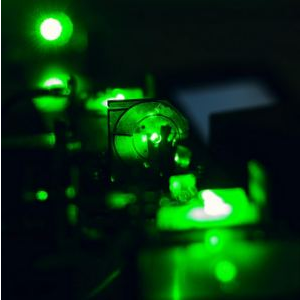Scientists at Samara University are preparing for testing a prototype of the world's first ultralight optical system for remote sensing of the Earth (ERS) for nanosatellites. The optical system is based on a flat diffraction lens developed at the university that has unique characteristics. The lens of the system will be mounted on board the nanosatellite in a special housing. The first test sample of such a case was made at the university laboratory of additive technologies. The component of the spacecraft, complex in shape and internal structure, was created by 3D printing using the SLM 280HL selective laser fusion unit.
"This is the first diffractive optics lens in the world to go into space. An innovative bionic housing designed for optimal lens technology has been developed for the lens to minimize weight while maintaining strength characteristics. It will be a fairly lightweight system, together with the optical part, the total weight will be less 100 grams," said Artem Nikonorov, professor at the Department of Supercomputers and General Informatics at Samara University.
According to the head of the laboratory, associate professor of the department of engine production technologies Vitaly Smelov, in order to minimize weight, special mesh sections were added to the internal structure of the part as a result of topological optimization. The lens body is made of AlSi10Mg aluminum alloy powder. Alloy of domestic production is well known both in Russia and abroad. Dimensions of the part - 70x80x100 mm.
"The case was made in 8 hours. Thanks to the use of additive technologies, it was possible to reduce the weight of the part by about 40% compared to a similar part made by traditional methods. As we know, in space and aviation weight is the main characteristic and we always work at reducing weight, "said Smelov.
Before heading into space, the assembled lens will undergo a series of various vibration and strength tests by the manufacturer of the spacecraft, “Sputniks” company in Moscow. According to Nikonorov, it is expected that the nanosatellite will be ready for launch at the end of 2020. The device will operate in orbit at a height of 430 km. The estimated lifetime in orbit is from one to three years.
“Flight tests in space will have to show the capabilities of this system, how much we need to refine the technology. The characteristics of the lens are quite good, we plan to obtain with the help of remote sensing resolution of images of the earth’s surface less than a hundred meters. The cost of the optical system, I think, will be considerably lower than similar systems from foreign companies, for example, the cost of a foreign lens for the Gecko Imager cubsat is 23 thousand euros, our system is much cheaper," Nikonorov emphasized.
As previously reported, work on the creation of an ultralight optical system for remote sensing of the Earth is carried out within the framework of a grant received by scientists from the Innovation Support Fund with the support of the government and the Ministry of Economic Development and Investment of the Samara Region.
The optical system is based on a flat diffraction lens created earlier at Samara University that replaces the system of lenses and mirrors of modern telephoto lenses. In the lens manufacturing process, a resist is applied to the surface of the quartz glass - a photosensitive substance with a thickness of 10 micrometers (for comparison, the thickness of a human hair is 40-90 micrometers). A laser beam creates a 256-level microrelief on the resist. With its help, an “approximation” of the object occurs, and distortion compensation is provided by computer processing of the resulting images based on deep learning neural networks. According to scientists, on the basis of a diffraction lens, you can make an analog of a telephoto lens with a focal length of 300 mm, which will weigh about 10 grams.
According to scientists, such miniature optical systems of nanosatellites in their resolution, of course, will be inferior to specialized optics installed on large remote sensing devices weighing from 500 kg to several tons. However, on the basis of low-budget nanosatellites with compact optics, it will be possible to create large-scale orbital constellations from hundreds of such spacecrafts, which will allow monitoring the Earth in almost real time, quickly obtaining an image of the necessary area of the earth’s surface and without waiting for when one or another large remote sensing satellite is over the right place. The information obtained will be important for operational tracking, for example, the situation with the spread of natural fires, floods, for monitoring agricultural crops and for other purposes.
For reference
Samara University is one of the world leaders in the study of diffractive optical elements and image processing. The diffraction lens developed at the university is one of the results of the 40-year-old work of the school of diffractive optics and nanophotonics under the guidance of Academician of the Russian Academy of Sciences, President of Samara University Viktor Soifer.
The first article by scientists at Samara University, confirming the possibility of using diffraction optics in imaging systems, was published in May 2015 following the results of the largest world conference on image processing - IEEE Computer Vision and Pattern Recognition. In November 2015, a joint work was published by the University of Toronto and King Abdullah University in Saudi Arabia on a similar development, with reference to the work of Samara University. Previously, no one in the world has used diffraction optics to obtain high-resolution color images. The use of planar diffraction optics in remote sensing systems is studied in a paper published in the journal IEEE Journal of Selected Topics in Applied Earth Observations and Remote Sensing.
